|
|
|
#1 |
|
Avalon Senior Member
Join Date: Sep 2008
Location: Gaia, Solas System, Milkyway
Posts: 398
|
I promised that i would post this, and im sure anyone with enough motivation can find it for themselves, it may be a good idea to have a database here on Avalon.
I will be taking quotes from other sites as i do not have the time to re-compile all the evidence myself. It doesnt seem natural to go to all that trouble when there is already many reliable sources out there. -------------------------------------------------------------------------- *Taken from UFOArea Website* *Recovered through WayBackMachine Website* "Our research indicates that the entire Great Lakes region (and beyond) was subjected to particle bombardment and a catastrophic nuclear irradiation that produced secondary thermal neutrons from cosmic ray interactions. The neutrons produced unusually large quantities of 239 Pu and substantially altered the natural uranium abundance ratios (235 U/238 U) in artifacts and in other exposed materials including cherts, sediments, and the entire landscape. These neutrons necessarily transmuted residual nitrogen (14 N) in the dated charcoals to radiocarbon, thus explaining anomalous dates." Richard B. Firestone Since Atlantis was in the America, and its people were from India, as Gene D. Matlock has certainly proven in his excellent book The Last Atlantis Book You'll Ever Have to Read, specifically in his chapter "Why Not Look for A-Tlan-Tis in America?" which we have included on this site, then, the Vimanas, war machines, bombs, and terrible wars spoken of in the old Sanskrit manuscripts probably existed not only in the Motherland of India but from there all the way to America, possibly all over the world. The destruction of Atlantis (A-Tlan-Tis) may not have been brought about by an earthquake, flood, or any other natural disaster, but may have actually been triggered by a nuclear explosion. Earthquakes, volcanic eruptions, floods, etc. may then have followed. A manuscript, composed in Sanskrit by King Bhoja deals with techniques of warfare, and in particular with certain types of war machines. The work is called Samarangana Sutradhara, or "Battlefield Commander (sometimes abbreviated "the Samar"). The whole of chapter 31 is devoted to the construction and operation of several kinds of aircraft having various methods of propulsion. King Bhoja, who used the Sanskrit term yantra more often than the more familiar vimana, claims his knowledge was based on Hindu manuscripts which were ancient even in his time, 11th century AD. Here are some excerpts from this ancient text: "They were propelled by air and inside is placed a mercury engine with an iron heating apparatus beneath. By means of the power latent in the mercury sets the driving whirlwind in motion. When it has been heated by the controlled fire from the iron containers a thunder power is developed through the mercury. If the iron engine with the properly wielded joints be filled with mercury and fire conducted into the upper part, it develops the power with the roar of the lion." "..inside it (the Vimana) one must place the mercury-engine with its iron heating apparatus beneath. By means of the power latent in the mercury which sets the driving whirlwind in motion, a man sitting inside may travel a great distance in the sky in a most marvelous manner. "Similarly by using the prescribed processes one can build a Vimana as large as the temple of the God-in-motion. Four strong mercury containers must be built into the interior structure. "When these have been heated by controlled fire from iron containers, the Vimana develops thunder-power through the mercury. And at once it becomes a pearl in the sky. "Moreover, if this iron engine with properly welded joints be filled with mercury, and the fire be conducted to the upper part it develops power with the roar of a lion." Did a War Take Place at the End of the Dryas Period? The ice cores show that at the end of the last ice age temperatures increased steadily for the next thousand years. Traces of copper, tin and lead show marked increases! The Older Dryas period ends abruptly with a dramatic drop in temperatures. Extinction of Mammoths as well as the megafauna of North and South America took place about this time. Uranium concentrations in coral jump dramatically from approx. 1.5 parts per million to over 4 parts per million at about this period. Radio carbon dates at this period are chaotic! Studies of layered deposits laid down by lakes provide confirmation of irregularities in the chronological record Fused desert sands have been found, notably in the Egyptian desert. All the evidence seems to support the existence of an ancient nuclear war having taken place in the past. There is no doubt that Samarangana Sutradhara, the Mahabharata, and many other ancient Indian texts exist. There are references to these texts in Indian government and scientific publications. The texts cover a very wide range of topics, from town planning, health and hygiene including a detailed description of vaccination, to wide ranging discussion of mechanics and scientific observation, method and theories. They describe electricity and mechanics that are in full agreement with science of today. They describe Vimanas, aircraft of many designs, that are all scientifically feasible. Note that the translator above was a person who did not understand the concepts of the ancient documents he was translating. There were no words in his own language of 11the century AD to describe the wonderful things in those ancient texts -- he did the best he could. Also keep in the mind these texts were written some time after a terrible nuclear war took place in which two great civilizations destroyed themselves. The survivors (or more likely, descendants of the survivors) of these civilizations were attempting to record their knowledge for future generations. And having been recorded quite some time after the disaster, the writers themselves were probably not scientists and probably did not understand the material they were recording. Errors may have occurred as well as these texts were copied and re-copied over the ages. Article taken from here. -------------------------------------------------------------------------- Radiation still so intense, the area is highly dangerous. A heavy layer of radioactive ash in Rajasthan, India, covers a three square mile area, ten miles west of Jodhpur. Scientists are investigating the site, where a housing development was being built. For some time it has been established that there is a very high rate of birth defects and cancer in the area under construction. The levels of radiation there have registered so high on investigators' gauges that the Indian government has now cordoned off the region. Scientists have unearthed an ancient city where evidence shows an atomic blast dating back thousands of years, from 8,000 to 12,000 years, destroyed most of the buildings and probably a half-million people. One researcher estimates that the nuclear bomb used was about the size of the ones dropped on Japan in 1945. The Mahabharata clearly describes a catastrophic blast that rocked the continent. "A single projectile charged with all the power in the Universe... An incandescent column of smoke and flame as bright as 10,000 suns, rose in all its splendor... it was an unknown weapon, an iron thunderbolt, a gigantic messenger of death which reduced to ashes an entire race. " The corpses were so burned as to be unrecognizable. Their hair and nails fell out, pottery broke without any apparent cause, and the birds turned white. "After a few hours, all foodstuffs were infected. To escape from this fire, the soldiers threw themselves into the river." A HISTORIAN COMMENTS Historian Kisari Mohan Ganguli says that Indian sacred writings are full of such descriptions, which sound like an atomic blast as experienced in Hiroshima and Nagasaki. He says references mention fighting sky chariots and final weapons. An ancient battle is described in the Drona Parva, a section of the Mahabharata. "The passage tells of combat where explosions of final weapons decimate entire armies, causing crowds of warriors with steeds and elephants and weapons to be carried away as if they were dry leaves of trees," says Ganguli. "Instead of mushroom clouds, the writer describes a perpendicular explosion with its billowing smoke clouds as consecutive openings of giant parasols. There are comments about the contamination of food and people's hair falling out." ARCHEOLOGICAL INVESTIGATION PROVIDES INFORMATION Archeologist Francis Taylor says that etchings in some nearby temples he has managed to translate suggest that they prayed to be spared from the great light that was coming to lay ruin to the city. "It's so mind-boggling to imagine that some civilization had nuclear technology before we did. "The radioactive ash adds credibility to the ancient Indian records that describe atomic warfare." Construction has halted while the five member team conducts the investigation. The foreman of the project is Lee Hundley, who pioneered the investigation after the high level of radiation was discovered. Article taken from here. I will add to this later on, there is much more. For now, adios. |
|
|

|
|
|
#2 |
|
Banned
Join Date: Sep 2008
Location: On a boat in Tacoma, wa, usa
Posts: 394
|
While this is good information, it should probably be in the Camelot area, , ,
the forum house rules and all, , , It would fit in with the war in our solar system though, , , http://www.projectavalon.net/forum/s...ead.php?t=3194 Last edited by Norval; 09-27-2008 at 01:48 PM. |
|
|

|
|
|
#3 | |
|
Banned
Join Date: Sep 2008
Location: Holland, 5 metres below sea level
Posts: 191
|
Quote:
|
|
|
|

|
|
|
#4 |
|
Avalon Senior Member
Join Date: Sep 2008
Location: Gaia, Solas System, Milkyway
Posts: 398
|
Did an ancient advanced civilization exist on Earth? The question is very intriguing and the search for “evidence” to support a positive answer has intrigued Mankind for many decades – if not centuries. Many possibilities have been put forward, from outright statements that Atlantis was a high tech civilization, to the possibility that the Nazca lines might be a prehistoric airport.
Rather than an accumulation of various items of evidence that is then subjected to the possibility that it might be either alien or advanced, it is more scientific – and perhaps better- to focus on the quest for the “best evidence”: a single piece of evidence that in itself is the best example to support a conclusion. In the search for an advanced ancient civilization, what would be this “best evidence”? One possible item that would classify as “best evidence” exists within the Indus River Valley, where towns such as Harappa and Mohenjo Daro flourished in 3000 BC. The question is why these cities were abandoned. And one answer that has been put forward is that the ancient cities might have been irradiated by an atomic blast. If true, it would be impossible to ignore the conclusion that ancient civilization possessed high technology. 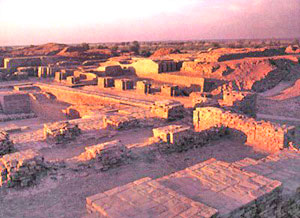 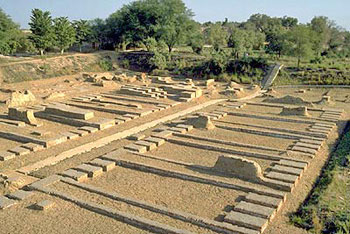 The story begins when a layer of radioactive ash was found in Rajasthan, India. It covered a three-square mile area, ten miles west of Jodhpur. The research occurred after a very high rate of birth defects and cancer was discovered in the area. The levels of radiation registered so high on investigators’ gauges that the Indian government cordoned off the region. Scientists then apparently unearthed an ancient city where they found evidence of an atomic blast dating back thousands of years: from 8,000 to 12,000 years. The blast was said to have destroyed most of the buildings and probably a half-million people. Archeologist Francis Taylor stated that etchings in some nearby temples he translated suggested that they prayed to be spared from the great light that was coming to lay ruin to the city. “It’s so mind-boggling to imagine that some civilization had nuclear technology before we did. The radioactive ash adds credibility to the ancient Indian records that describe atomic warfare.” When excavations of Harappa and Mohenjo-Daro reached the street level, they discovered skeletons scattered about the cities, many holding hands and sprawling in the streets as if some instant, horrible doom had taken place. People were just lying, unburied, in the streets of the city. And these skeletons are thousands of years old, even by traditional archaeological standards. What could cause such a thing? Why did the bodies not decay or get eaten by wild animals? 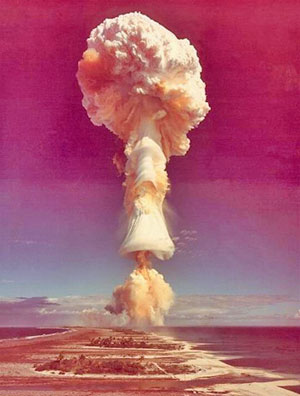 Furthermore, there is no apparent cause of a physically violent death. A. Gorbovsky, in Riddles of Ancient History, reported the discovery of at least one human skeleton in this area with a level of radioactivity approximately 50 times greater than it should have been due to natural radiation. Furthermore, thousands of fused lumps, christened “black stones”, have been found at Mohenjo-Daro. These appear to be fragments of clay vessels that melted together in extreme heat. Another curious sign of an ancient nuclear war in India is a giant crater near Bombay. The nearly circular 2,154-metre-diameter Lonar crater (bottom image), located 400 kilometers northeast of Bombay and aged at less than 50,000 years old, could be related to nuclear warfare of antiquity. No trace of any meteoric material, etc., has been found at the site or in the vicinity, and this is the world’s only known “impact” crater in basalt. Indications of great shock (from a pressure exceeding 600,000 atmospheres) and intense, abrupt heat (indicated by basalt glass spherules) can be ascertained from the site. 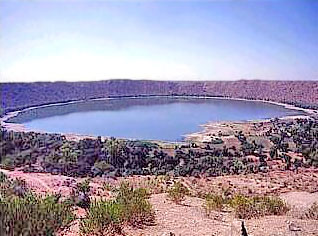 With the apparent discovery of this radiated area, parallels were quick drawn to the Mahabharata, the Indian epic. It reads: ... (it was) a single projectile Charged with all the power of the Universe. An incandescent column of smoke and flame As bright as the thousand suns Rose in all its splendor... ...it was an unknown weapon, An iron thunderbolt, A gigantic messenger of death, Which reduced to ashes The entire race of the Vrishnis and the Andhakas. ...The corpses were so burned As to be unrecognizable. The hair and nails fell out; Pottery broke without apparent cause, And the birds turned white. After a few hours All foodstuffs were infected... ....to escape from this fire The soldiers threw themselves in streams To wash themselves and their equipment. 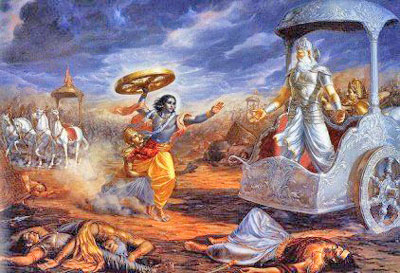 Whereas the story of the Mahabharata is indirect evidence, the other discoveries in India pose serious problems for those trying to deny the possibility that this might indeed be evidence of ancient atomic warfare. Whereas believing in the existence of Atlantis or a highly advanced civilization that might not have left any trace is one thing, to suggest that our ancestors might have wiped themselves out along the same lines we almost did, but only fifty years ago, is a major paradigm shift. Some skeptics thus stated: “I am sick and tired of hearing this, and I cannot find any debunks of this either. Anyone who can debunk this, or is this really true?” That is indeed the question… and an important one. The stakes are high, as one would expect when facing with the best evidence. 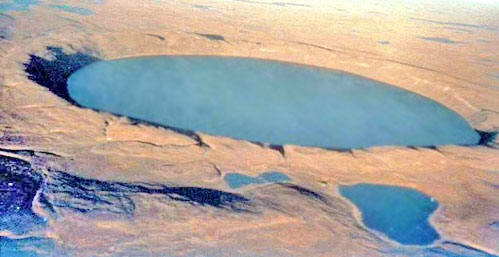 So, let us discover what might be the best evidence. The first question is whether a Francis Taylor existed. There is a Francis Taylor, an American museum director, who died in 1957. He was not an archaeologist. There is a “Francisco Taylor”, but he is not the above quoted Francis Taylor. Not a good start. Skeptics have also wondered whether the ancient atomic warfare is not a modern invention, to deflect attention from a serious – modern – atomic contamination. In 1998, it was reported that an Indian power stations had some major problems. One had an incident in which 2000 workers became exposed to excess radiation, 300 of which had to be hospitalized. Surendra Gadekar also investigated the conditions of villagers at Rawatbhatta in Rajasthan and discovered gross radiation-related deformities. We note that Rawatbhatta is in the same region as the discovery of the “ancient warfare” site. But Gadekar did not find evidence of ancient warfare, but evidence of modern negligence: wood that had been used in the power plant, had then “somehow” made his way into society, where it was subsequently used as wood for a fire. This in itself was a minor incident, but could there have been more serious incidents, whereby it was decided to deflect attention from the present to the ancient past? We thus find that there no newspapers carried the story of the discovery. The Indian archaeological authorities are not aware of the story. And there is a government laboratory in Jodhpur, Rajasthan. Might something have gone wrong in the latter? With the above objections, the case for the best evidence has become more controversial than a clean-cut case. But in a case such as an ancient high tech civilization, this should not come as a surprise. Rome was not built in one day, and arguing for or against the case of an ancient highly advanced civilization will not take any less time. There should also not be a rush to judgment: the case for ancient warfare in India is currently better than any contradictory evidence. The bodies of Harappa and Mohenjo Daro remain a mystery, whether or not the other radioactive site turns out to be modern or ancient. The anomalous crater adds power to the possibility. Finally, the fact that all these enigmas are within one general region (as opposed to scattered across the world) adds further weight to the case… but then this should be expected if we might consider this case to be the best evidence. The problem of the “best evidence” is often that it sounds too good to be true. That is either because it is, or because it is indeed the “best evidence”. And only careful analysis of the evidence will reveal what it is… Article taken from here. Last edited by 2infinityandbeyond; 09-27-2008 at 06:47 PM. |
|
|

|
|
|
#5 | |
|
Avalon Senior Member
Join Date: Sep 2008
Location: Gaia, Solas System, Milkyway
Posts: 398
|
Quote:
Ive much more to add to this, and it will probably take up quite a few pages so maybe it might be best to leave it sitting on its own. I will post more as time goes on, it wouldnt be a good idea to overwhelm this thread with information just yet before everyone gets a chance to digest what is here already. |
|
|
|

|
|
|
#6 |
|
Avalon Senior Member
Join Date: Sep 2008
Location: a box in the inner city w. a slight chance of suburbia New Jersey
Posts: 160
|
i never understood why people find it soo hard to understand ancient civilizations have advanced father then present day society has in some aspects. Id say theirs a 100% chance we weren't the first to play with matches.
|
|
|

|
|
|
#7 |
|
Avalon Senior Member
Join Date: Sep 2008
Location: Gaia, Solas System, Milkyway
Posts: 398
|
|
|
|

|
|
|
#8 |
|
Avalon Senior Member
Join Date: Sep 2008
Location: U.K. Earth
Posts: 248
|
I think we've been here before - any times - this is not the fisrt time that peoples of this planet have reach this point in advancement - a little like in the film The Matrix, I think they had been there seven times before and destruction hit him - this might be the same here. We get to a point and then something happens - like the Cern accelerator being turned on and ending life as we know it and then it all starts again - the reset button so to speek...
|
|
|

|
|
|
#9 |
|
Avalon Senior Member
Join Date: Sep 2008
Posts: 53
|
Fascinating post! Has anyone read the rather daunting tome 'Forbidden Archaeology' by Michael Cremo? I rather think it links with this post insofar as highly intelligent and technologically brilliant life forms on this blue planet can be proven to be very very much older than we are currently led to believe. Also - the electric universe may play a major role in the events described in this post - No?
|
|
|

|
|
|
#10 |
|
Banned
Join Date: Sep 2008
Location: On a boat in Tacoma, wa, usa
Posts: 394
|
 No No
|
|
|

|
|
|
#11 |
|
Banned
Join Date: Sep 2008
Location: On a boat in Tacoma, wa, usa
Posts: 394
|
This is a great thread. It has alot of very good information in it.
It is a major part of what the bible very briefly mentions of what it was like just prior to the flood of Noah. 
|
|
|

|
|
|
#12 | |
|
Avalon Senior Member
Join Date: Sep 2008
Location: Gaia, Solas System, Milkyway
Posts: 398
|
Quote:
I would just like to add that i can take no credit for the research posted here, although i have compiled my own data along with much of my own research it is unfortunatly scattered between quite a few computers and i dont feel the need to go to the trouble of gathering it when there is identical research elsewhere, already online. The research posted and that posted hereafter is taken from external sources, I am happy to provide a link to the source at the bottom of each article. Last edited by 2infinityandbeyond; 09-28-2008 at 05:06 PM. |
|
|
|

|
|
|
#13 |
|
Avalon Senior Member
Join Date: Sep 2008
Location: Gaia, Solas System, Milkyway
Posts: 398
|
 by Richard B. Firestone & William Topping Mammoth Trumpet Volume 16, Number 2 March 2001 from CenterFirstAmericans Website The Paleoindian occupation of North America, theoretically the point of entry of the first people to the Americas, is traditionally assumed to have occurred within a short time span beginning at about 12,000 yr B.P. This is inconsistent with much older South American dates of around 32,000 yr B.P.1 and the similarity of the Paleoindian toolkit to Mousterian traditions that disappeared about 30,000 years ago.2 A pattern of unusually young radiocarbon dates in the Northeast has been noted by Bonnichsen and Will.3, 4 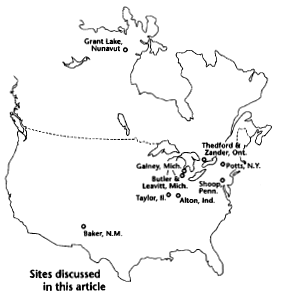 Our research indicates that the entire Great Lakes region (and beyond) was subjected to particle bombardment and a catastrophic nuclear irradiation that produced secondary thermal neutrons from cosmic ray interactions. The neutrons produced unusually large quantities of 239Pu and substantially altered the natural uranium abundance ratios (235U/238U) in artifacts and in other exposed materials including cherts, sediments, and the entire landscape. These neutrons necessarily transmuted residual nitrogen (14N) in the dated charcoals to radiocarbon, thus explaining anomalous dates. The evidence from dated materials We investigated a cluster of especially young radiocarbon dates concentrated in the north-central area of North America. For example, at the Gainey site in Michigan a 2880 yr B.P. radiocarbon date was reported, while the thermoluminescence date for that site is 12,400 yr B.P.5 Other anomalous dates found at Leavitt in Michigan,6 Zander and Thedford in Ontario,7 Potts in New York,8 Alton in Indiana,9 and Grant Lake in Nunavut10 are summarized in Table 1. The Grant Lake Paleoindian site is most remarkable because its 160 [rc] yr B.P. age is nearly contemporary, while adjacent and deeper samples give ages of 1480-3620 [rc] yr B.P. Stratigraphic associations place Paleoindian occupations at depth on the prehistoric North American landscape on sediments that form the old C horizon composed of parent material, Wisconsinan deposits that predate Holocene sediment buildup.11,12,13 The young Paleoindian dates cannot be correct, particularly since there are no patterned anomalies noted in later-period prehistoric assemblages relating to higher stratigraphic positions. In a pioneering study of the Paleoindian site at Barnes, Michigan, Wright and Roosa observed that Paleoindian artifacts were deposited before the formation of spodosols ceased in this area about 10,000 yr B.P.14 This conclusion was based on observing that cemented sediments on artifacts, found outside their original context, defines their original stratigraphic position. The evidence from particle bombardment Sediment profiles were taken at Paleoindian sites and at numerous widely separated control locations in Michigan. The C sediment horizon is clearly recognized by its transitional color and confirmed by elevated concentrations of potassium and other isotopes. Color and chemistry are key indicators of this very old soil11,12,13,14 derived from parent materials and associated postglacial runoff.15 At Gainey, large quantities of micrometeorite-like particles appear to be concentrated near the boundary between the B and C sediment horizons. They can be separated with a magnet and are identified by the presence of chondrules and by visual evidence of sintering and partial melting. These particles, dissimilar to common magnetites, are found in association with a high frequency of "spherules." The depth profiles for potassium and particles at the Gainey site are compared in Fig. 1. Minor vertical sorting of particles is apparent, with a shallow spike of particles near the surface probably resulting from modern agricultural or industrial activity. Total gamma-ray counting of sediment profiles in the various locations invariably showed increased radioactivity at the B-C boundary consistent with enhanced potassium (40K) and possibly other activities. Microscopic examination of chert artifacts from several widely separated Paleoindian locations in North America revealed a high density of entrance wounds and particles at depths that are evidence of high-velocity particle bombardment. Chondrules were identified visually; their presence necessarily indicates heating during high-speed entry into the atmosphere. The depth of penetration into the artifacts implies that the particles entered with substantial energy.16 Field simulations with control cherts for large particles (100-200 microns) suggest an entrance velocity greater than 0.4 km/s, and experiments at the National Superconducting Cyclotron Laboratory indicate that the smaller particles left tracks comparable to about 526 MeV iron ions (56Fe) in Gainey artifacts. Similar features are not observed in later-period prehistoric artifacts or in bedrock chert sources. Track angles were estimated visually; track densities were measured with a stage micrometer; track depths were found by adjusting the microscope focus through the track. These data are summarized in Table 1. 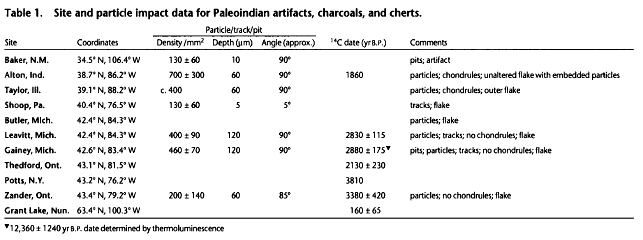 Track and particle data in Table 1 suggest that the total track volume (density times depth) is highest at the Michigan, Illinois, and Indiana sites and decreases in all directions from this region, consistent with a widespread catastrophe concentrated over the Great Lakes region. The nearly vertical direction of the tracks left by particle impacts at most sites suggests they came from a distant source. A barn is a unit of area equal to 10-24 cm2, used in nuclear physics. The fraction of isotopes that are transformed by a nuclear reaction is given by s x I, where s is the cross section in cm2 of the target presented by an atom, and I is the neutron flux per cm2 impinging on the target. Most neutron-induced reactions involve the capture of a neutron to produce a heavier isotope of the same element. Exceptions include 14N, which captures a neutron and emits a proton to produce 14C; and 235U, which mainly fissions into two lighter elements. The relative size of isotopes in chert is shown in figure "A neutron's view of chert." The evidence from uranium and plutonium Natural uranium, which is ubiquitous in cherts, has a 235U/238U isotopic ratio of 0.72 percent, which varies by less than 0.1 percent in natural sources.17 Significant variations in the isotopic ratio do not occur because of chemical processes; however, a thermal neutron bombardment depletes 235U and thus alters the ratio. Solar or galactic cosmic rays interacting with matter produce fast secondary neutrons that become thermalized by scattering from surrounding materials. Thermal neutrons see a target of large cross section (681 barns) A for destroying 235U, compared with a target of only 2.68 barns for neutron capture on 238U. Therefore, despite the low abundance of 235U, about 1.8 times as many 235U atoms are destroyed as 238U atoms by thermal neutrons. If a large cosmic-ray bombardment impacted the earth and irradiated the prehistoric landscape with thermal neutrons, the 235U/238U ratio would be changed; 239Pu would be produced from neutron capture on 238U, followed by the decay of 239U. Neutrons colliding with nitrogen (1.83 barns) would create 14C in exactly the same way 14C is normally produced in the upper atmosphere, necessarily resetting the radiocarbon dates of any organic materials lying near the surface on the North American prehistoric landscape--including charcoals at Paleoindian sites--to younger values. 239Pu produced during the bombardment will also be partly destroyed by thermal neutrons with 1017 barn cross section. Assuming 239Pu doesn't mobilize, it will decay back to 235U (half-life 24,110 yr), partially restoring the normal abundance. 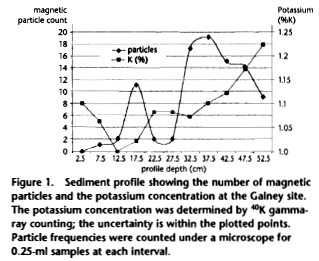 Paleoindian artifacts from Gainey, Leavitt, and Butler, and two later-period artifacts from the same geographic area of Michigan were analyzed for 235U content by gamma-ray counting at the Phoenix Memorial Laboratory, University of Michigan. They were compared with identical chert types representative of the source materials for the artifacts. Control samples were extracted from the inner core of the purest chert known to be utilized by prehistoric people. The Paleoindian artifacts contained about 78 percent as much 235U as the controls and later-period artifacts, suggesting substantial depletion. Depletion of 235U necessarily indicates that thermal neutrons impacted these artifacts and the surrounding prehistoric landscape. Various artifacts, cherts, sediments, and a control sample containing about 0.2 percent uranium obtained from uraninite were sent to the McMaster University Centre for Neutron Activation Analysis to determine 235U concentration by delayed neutron counting and 238U concentration by activation analysis. These results are shown in Table 2. The 235U/238U ratios for all samples except the control deviated substantially from the expected ratio. McMaster ran additional calibration standards and has considerable expertise analyzing low-level uranium. 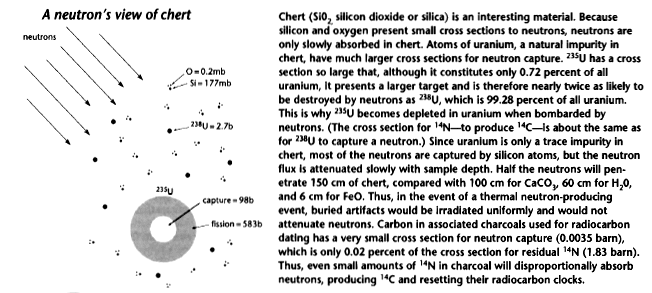 This analysis was sensitive to a few ppb for 235U and 0.1-0.3 ppm for 238U, more than sufficient to precisely analyze the uranium-rich chert samples (0.7-163.5 ppm). Most samples were depleted in 235U, depletion increasing geographically from the southwest (Baker, Chuska chert, 17 percent) to the northeast (Upper Mercer, 77 percent), as shown in Table 2. This is consistent with cosmic rays focused towards northern latitudes by Earth's magnetic field. Only a very large thermal neutron flux, greater than 1020 n/cm2, could have depleted 235U at all locations. 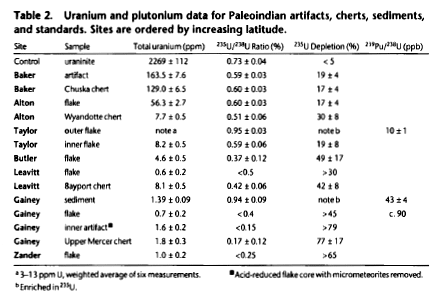 Samples of unaltered flakes from Taylor and sediment originally adjacent to Gainey artifacts showed 235U enriched by 30 percent. Both samples were closely associated with the particles described above. The position of these samples appears to be related to the enrichment, which cannot be explained by thermal neutrons from the bombardment. To test this, we bathed another Taylor flake in 48-percent HF at 60°F for ten minutes to remove the outer 70 percent of the sample and the attached particles. Analysis showed the "inner" flake depleted in 235U by 20 percent, consistent with the other depleted cherts. Samples of Gainey sediment and Taylor flakes were analyzed for plutonium by Nuclear Technology Services, Inc., of Roswell, Georgia, which specializes in radiochemistry using standard methodology. The plutonium, with an aliquot of NIST-traceable 242Pu added, was chemically separated on an anion exchange resin column and counted on an alpha-particle spectrometer. The 239Pu/238U ratios in both samples were approximately 10 ppb, vastly exceeding the expected ratio of 0.003 ppb.18 The results of this analysis are shown in Table 2. Chert is a glass-like material highly impervious to penetration by any nuclear fallout that might also contribute 239Pu. We analyzed a long-exposed piece of Bayport chert by gamma-ray counting at the LBNL low-background facility for the presence of cesium-137 (137Cs), a key indicator of fallout (from nuclear testing), and found none. The B-C interface typically lies sufficiently deep that contamination by fallout is improbable. It is important to note that fallout cannot explain the depletion of 235U. Since the depletion of 235U must have resulted from bombardment by thermal neutrons, the presence of 239Pu from irradiation of 238U is expected. The total thermal neutron flux required to produce the observed 239Pu concentration can be calculated from the relative concentrations of 239Pu (corrected for the decay) and 238U, and the thermal neutron-capture cross section for 238U. This neutron flux can then be used to estimate the amount of additional 14C that would have been produced in charcoal by neutrons colliding with 14N (14N cross section = 1.83 barns). The corrected radiocarbon age can then be estimated by comparing the current amount of 14C in the dated charcoals, determined from their measured radiocarbon age, with the amount of 14C that would have been produced by the bombardment. For these calculations we assume that charcoal contains 0.05 percent residual nitrogen19 and that initial 14C concentrations were the same as today (one 14C atom for 1012 12C atoms). We derive a thermal neutron flux of c. 1017 n/cm2 at Gainey, which corresponds to an approximate date of 39,000 yr B.P. No radiocarbon date is available for the more southerly Taylor site, but for the conventional range of accepted Paleoindian dates the neutron flux would be c. 1016 n/cm2, giving a date of about 40,000 yr B.P. These calculations necessarily neglect differences in the neutron flux experienced by the dated charcoal and the artifacts, the effects of residual 239Pu from previous bombardments, and loss of 239Pu due to leaching from chert over time. The neutron flux calculated from the 235U/238U ratio is more than 1000 times that implied by the level of 239Pu. Since 239Pu decays to 235U, partly restoring the natural abundance, it appears that substantial quantities of 239Pu have migrated out of the chert. This mobility is demonstrated at the Nevada Test Site, where plutonium, produced in nuclear tests conducted by the U.S. between 1956 and 1992, migrated 1.3 km.20 It has also been shown that atoms produced by radioactive decay or nuclear reaction become weakly bound to the parent material and pass more readily into solution than isotopes not affected.21 Both 239Pu and 235U are thus expected to be mobile, complicating any analysis. This is consistent with the enrichment of 235U in the two external samples where migrating 239Pu or 235U may have been trapped, thus enriching the relatively uranium-poor outer regions. Alternatively, excess 235U may have been carried in by the particles. Radiocarbon produced in situ by irradiation should also be mobile. If 14C is more mobile than 239Pu, then the dates calculated above should be decreased accordingly. Redating North American sites The 39,000 yr B.P. date proposed for the Gainey site is consistent with the prevailing opinion among many archaeologists about when the Americas were populated. It is also commensurate with dates for South American sites and with a Mousterian toolkit tradition that many see as the Paleoindian precursor. The proposed date for the Gainey site also falls closer in line with the radiocarbon date for a Lewisville, Texas, Paleoindian site of 26,610 ± 300 yr B.P.22,23 and radiocarbon dates as early as c. 20,000 yr B.P. for Meadowcroft Rockshelter.24 Since the Lewisville and Meadowcroft sites were likely exposed at the same time to thermal neutrons, we estimate that their dates should be reset to c. 55,000 yr B.P. and c. 45,000 yr B.P., respectively. It is likely that Paleoindians occupied low latitudes during the full glacial and migrated to more northerly areas as the ice front retreated. Therefore the pattern of dates makes sense from the archaeologist's point of view. Dates for North American sites should generally be reset by up to 40,000 years, depending on latitude and overburden. Geologists believe that before c. 15,000 yr B.P. the Wisconsinan glaciation covered the more northerly locations where Paleoindian sites have been found.25 The ice sheet would have shielded the landscape and any artifacts from an irradiation. (The Gainey thermoluminescence date of 12,400 yr B.P. is probably a result of the heat generated by the nuclear bombardment at that time, which would have reset the TL index to zero.) The modified dates for Paleoindian settlements suggest that the timetable for glacial advance sequences, strongly driven by conventional radiocarbon dates, should be revisited in light of the evidence presented here of much older occupations than previously thought." The alignment of magnetic particles in sediment indicates that the Earth's magnetic poles have repeatedly reversed their polarity in the past. Complete magnetic excursions occurred about 10 times in 4.5 million years; the last reversal occurred about 700,000 years ago. Magnetic excursions occur every 10,000-20,000 years when the Earth's magnetic field becomes weak, and the poles may even reverse for a short time. The evidence from tree rings and marine sediments A large nuclear bombardment should have left evidence elsewhere in the radiocarbon record. It is well known that radiocarbon dates are increasingly too young as we go back in time. The global Carbon Cycle suggests that 14C produced by cosmic rays would be rapidly dispersed in the large carbon reservoirs in the atmosphere, land, and oceans.26 We would expect to see a sudden increase in radiocarbon in the atmosphere that would be incorporated into plants and animals soon after the irradiation; after only a few years, most of the radiocarbon would move into the ocean reservoirs. The 14C level in the fossil record would reset to a higher value. The excess global radiocarbon would then decay with a half-life of 5730 years, which should be seen in the radiocarbon analysis of varved systems. 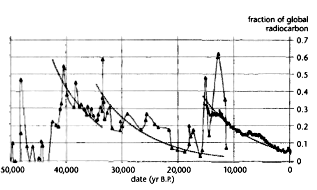 Fig. 2 plots 14C from the INTCAL98 radiocarbon age calibration data of Stuiver et al. for 15,000-0 yr B.P.27 and Icelandic marine sediment 14C data measured by Voelker et al. for 50,000-11,000 yr B.P.28 Excess 14C is indicated by the difference between the reported radiocarbon dates and actual dates. Sharp increases in 14C are apparent in the marine data at 40,000-43,000, 32,000-34,000 and c. 12,000 yr B.P These increases are coincident with geomagnetic excursions B that occurred at about 12,000 (Gothenburg), 32,000 (Mono Lake), and 43,000 yr B.P. (Laschamp),29 when the reduced magnetic field would have made Earth especially vulnerable to cosmic ray bombardment. The interstitial radiocarbon data following the three excursions were numerically fit, assuming exponential decay plus a constant cosmic ray-produced component. The fitted half-lives of 5750 yr (37,000-34,000 yr B.P.), 6020 yr (32,000-16,000 yr B.P.), and 6120 yr (12,000-0 yr B.P.) are in good agreement with the expected value. We also determined that contemporary radiocarbon contains about 7 percent residual 14C left over from the catastrophe. The constant cosmic ray production rate was about 34 percent higher for the Icelandic sediment than the INTCAL98 samples, perhaps implying higher cosmic ray rates farther north. Disregarding fluctuations in the data from variations in ocean temperatures and currents, the results are clearly consistent with the decay of radiocarbon following the three geomagnetic excursions. In Fig. 2, the sharp drop in 14C activity before 41,000 yr B.P. suggests that global radiocarbon increased by about 45 percent at that time and by about 20 percent at 33,000 and 12,000 yr B.P The results are remarkably consistent with Vogel's comparison of 14C and U-Th dates of a stalagmite that indicates global radiocarbon increased about 75 percent from 30,000 to 40,000 yr B.P. and about 30 percent around 18,000 yr B.P.30 McHargue et al. found high levels of 10Be in Gulf of California marine sediments at 32,000 and 43,000 yr B.P.C that could not be explained by magnetic reversal alone and were attributed to cosmic rays, possibly from a supernova.29 The geomagnetic excursion at 12,500 yr B.P. coincides with the thermoluminescence date from Gainey, and additional evidence for a cosmic ray bombardment at that time is found in the increases of 10Be,31 Ca,32 and Mg32 in Greenland ice cores around 12,500 yr B.P. Similar increases are also seen in the data for NO3-, SO4-, Mg+, Cl-, K+, and Na+ ions in Greenland ice cores.33 This occurrence can be dated precisely to 12,500 ± 500 yr B.P., an average of the remarkably consistent concentration peak centroids in the Greenland ice core data. Significant increases at that time are not found in comparable data for the Antarctic, which indicates that the cosmic ray irradiation was centered in the Northern Hemisphere. Weak evidence of an occurrence at 12,500 yr B.P. is seen in the radiocarbon record for marine sediments near Venezuela,34 confirming that the cosmic ray bombardment was most severe in northern latitudes. Lunar cosmogenic data also show evidence of increased solar cosmic ray activity at or before 20,000 yr B.P.35,36 although these data are not sensitive to earlier irradiation. Beryllium occurs naturally as 9Be. 10Be is produced by cosmic rays, mostly protons, striking the atmosphere and breaking apart nitrogen and oxygen. It has a half-life of 1.5 million years. Unlike 14C, which is caught up in the global Carbon Cycle, 10Be is inert and falls as dust. 10Be is produced almost entirely by galactic cosmic rays, which are much higher in energy than solar cosmic rays. Thus any increase in 10Be would be cosmic in origin; and the cosmic ray rate could only change if there were a nearby supernova. During the last Ice Age the 10Be deposition rate in ice at both poles was much higher than today. Gulf of California marine sediments clearly show strong 10Be peaks at 32,000 and 43,000 yr B.P. McHargue argues that these peaks can only be explained by a supernova. The effect of a supernova on Earth Sonett suggests that a single supernova would produce two or three shock waves, an initial forward shock and a pair of reverse shocks from the initial expansion and a reflected wave from the shell boundary of a more ancient supernova.39,40 Fig. 2 shows that each episode in a series produced a similar amount of atmospheric radiocarbon. The sun lies almost exactly in the center41 of the Local Bubble, believed to be the result of a past nearby supernova event. A candidate for the reverse shock wave is the supernova remnant North Polar Spur, with an estimated age of 75,000 years and a distance of 130 ± 75 parsecs (424 light years),42 conveniently located in the north sky from where it would have preferentially irradiated the Northern Hemisphere. Assuming the Taylor flux is average and 1,000 neutrons are produced per erg of gamma-ray energy,43 the catastrophe would have released about 1016 erg/cm2 (2 x 108 cal/cm2), corresponding to a solar flare of 1043 ergs or a gamma-flash of 1054 ergs from a supernova about 1 parsec away.  The geographical distribution of particle tracks, 235U depletion, and 239Pu concentration shown in Fig. 3 are quite consistent, although the particle tracks seem to be confined to a smaller geographic area. They indicate energy released over the northeastern sector of the U.S., with maximum energy at about 43° N, 85° W, the Michigan area of the Great Lakes region. A history of suspected cosmic cataclysms over the ages Wdowczyk and Wolfendale 44 and Zook 36 propose, based on the existing record of solar flare intensities, that solar flares as large as 3 x 1038 ergs should be expected every 100,000 years. Clark et al. estimate that supernovas release 1047-1050 ergs within 10 parsecs of Earth every 100 million years.45 Brackenridge suggests that a supernova impacted the earth in Paleoindian times.46 Damon et al. report evidence from the 14C tree ring record that SN1006, which occurred at a distance of 1300 parsecs, produced a neutron shower of 2 x 108 n/cm2.47 Castagnoli et al. report evidence of the past six nearby supernovae from the thermoluminescence record of Tyrrhenian sea sediments.48 Dar et al. suggest that a cosmic ray jet within 1000 parsec would produce 1012 muons/cm2 (greater than 3 x 109 eV) and 1010 protons and neutrons/cm 2 (greater than 106 eV) and deposit over 1012 erg/cm2 in the atmosphere every 100 million years.49 A cosmic ray jet is also predicted to produce heavy elements via the r-process and could be a source of 235U enriched up to 60 percent in uranium. The Paleoindian catastrophe was large by standards of all suspected cosmic occurrences. Normal geomagnetic conditions would focus cosmic rays towards the magnetic poles, concentrating their severity in those regions. However, low magnetic field intensity during a geomagnetic excursion may have allowed excessive cosmic rays to strike northeastern North America. (Whether the geomagnetic excursion admitted cosmic radiation, or the radiation caused the excursion, is uncertain. Given our present state of knowledge, cause and effect in this instance are unclear.) The presence of a nearby small and dense interstellar cloud may explain the origin of the particle bombardment.50 The size of the initial catastrophe may be too large for a solar flare, but a sufficiently powerful nearby supernova or cosmic ray jet could account for it. It appears that the catastrophe initiated a sequence of events that may have included solar flares, impacts, and secondary cosmic ray bombardments. A devastating effect on Earth The enormous energy released by the catastrophe at 12,500 yr B.P. could have heated the atmosphere to over 1000°C over Michigan, and the neutron flux at more northern locations would have melted considerable glacial ice. Radiation effects on plants and animals exposed to the cosmic rays would have been lethal, comparable to being irradiated in a 5-megawatt reactor more than 100 seconds. The overall pattern of the catastrophe matches the pattern of mass extinction before Holocene times. The Western Hemisphere was more affected than the Eastern, North America more than South America, and eastern North America more than western North America.51,52,53 Extinction in the Great Lakes area was more rapid and pronounced than elsewhere. Larger animals were more affected than smaller ones, a pattern that conforms to the expectation that radiation exposure affects large bodies more than smaller ones.54,55 Sharp fluctuations of 14C in the Icelandic marine sediments at each geomagnetic excursion are interesting; because global carbon deposits in the ocean sediments at a rate of only about 0.0005 percent a year, a sudden increase in sediment 14C may reflect the rapid die-off of organisms that incorporated radiocarbon shortly after bombardment. 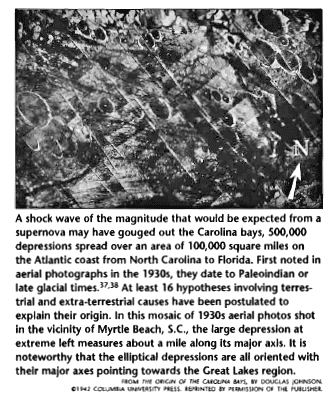 Massive radiation would be expected to cause major mutations in plant life. Maize probably evolved by macro-mutation at that time,55,56 and plant domestication of possibly mutated forms appears worldwide after the Late Glacial period. For example, there was a rapid transition from wild to domesticated grains in the Near East after the catastrophe.57 Implications for future study Much of what we assume about the Paleoindian period and the peopling of the Americas has been inferred from conventional radiocarbon chronology, which often conflicts with archaeological evidence. This work mandates that conventional radiocarbon dates be reinterpreted in light of hard terrestrial evidence of exposure of the radiocarbon samples to a cosmological catastrophe that affected vast areas of North America and beyond. A nuclear catastrophe can reset a group of unrelated artifacts to a common younger date, creating gaps and false episodes in the fossil record. Geographical variation and complicated overburdens may further confuse the interpretation. Scrutiny of Paleoindian artifacts and the North American paleolandscape, associated stratigraphic sediments, coupled with continued radiological investigations, may provide more evidence for the cosmic catastrophe and new clues to the origin of Paleoindians. References 1 Gruhn, R., in Clovis: Origins and Adaptations, R. Bonnichsen, K. L. Turnmire, eds. (Oregon State University Press, Corvallis, 1991), pp. 283-286. 2 Muller-Beck, H., Science 152, 1191 (1985). 3 Bonnichsen, R., in Clovis: Origins and Adaptations, R. Bonnichsen, K. L. Turnmire, eds. (Oregon State University Press, Corvallis , 1991), pp. 309-329. 4 Bonnichsen, R., F. Will, in Ice Age Peoples of North America, R. Bonnichsen, K. L. Turnmire, eds. (Oregon State University Press, Corvallis, 1999), pp. 395-415. 5 Simons, D. B., M. J. Shott, H. T. Wright, Arch. East. Nor. Amer. 12, 266 (1984). 6 Shott, M.J., The Leavitt Site (Museum of Anthropology, Ann Arbor, 1993). 7 Stewart, A., Ontario Arch. 41, 45 (1984). 8 Gramly, R. M., J. Lothrop, Arch. East. Nor. Amer. 12, 1222 (1984). 9 Tomak, C. H., Dancey Ohio Arch. Coun., Columbus, 117 (1994). 10 Wright, J. V., Borden Number Kkln-2, Lab No. S-833. Canadian Archaeology Association C14 Database Search, http://www.canadianarchaeology.com/l.../c14search.htm 11 S. Boggs, S., Principles of Sedimentology and Stratigraphy (MacMillan, New York, 1987). 12 Easterbrook, D. J., Surface Processes and Landforms (MacMillan, New York, 1993). 13 Birkeland, P. W., Soils and Geomorphology (Oxford University Press, New York, 1984). 14 Wright, H. T., W. B. Roosa, American Antiquity 31, 850 (1966). 15 Turner, M. D., E. J. Zeller, G. A. Dreschoff, J. C. Turner, in Ice Age Peoples of North America, R. Bonnichsen, K. L. Turnmire, eds. (Oregon State University Press, Corvallis, 1999), pp. 42-77. 16 firestone, R. B., W. Topping, Paleoindian Nuclear Event, http://ie.lbl.gov/Paleo/paleo.html 17 Kuroda, P. K., The Origin of the Chemical Elements, (Springer-Verlag, Berlin Heidelberg, 1982). 18 Seaborg, G. T., W. D. Loveland, The Elements beyond Uranium, (John Wiley & Sons, Inc., New York, 1990). 19 Ostrom, N., analysis at Michigan State University of charcoal and wood dated at 2800 and 42,000 yr B.P. respectively, private communication. 20 Kersting, A. B., et al., Nature 397, 56 (1999). 21 Cherdyntsev, V. V., Abundance of Chemical Elements. (The University of Chicago Press, Chicago, translated by W. Nichiporuk, 1961). 22 Wormington, H. M., Ancient Man in North America, (The Denver Museum of Natural History, Denver, 1957). 23 Shirley, R. H., et al., Environmental Geology Notes 109, 1985. 24 Adovasio, J. M., R. C. Carlisle, Science 239, 713 (1988). 25 Farrand, W. R., The Glacial Lakes around Michigan, Bulletin 4. (Geological Survey Division, Michigan Department of Environmental Quality, 1988). http://www.deq.state.mi.us/gsd/Gltext.html 26 Schimel, D. S., et al., in Climate Change 1994. Radiative Forcing of Climate Change and An Evaluation of the IPCC IS92 Emission Scenarios, J. T. Houghton, L. G. M. Filho, J. Bruce, H. Lee, B. A. Callander, E. Haites, N. Harris, and K. Maskell, eds. (IPCC Report. Cambridge University Press, Cambridge, 1994). 27 Stuiver, M., et al., Radiocarbon 40, 1041 (1998). 28 Voelker, A. H. L., et al., Radiocarbon 40, 517 (1998). 29 McHargue, L. R., P. E. Damon, D. J. Donahue, Geophys. Res. Lett. 22, 659 (1995). 30 Vogel, J. C., Radiocarbon 25, 213 (1983). 31 Finkel, R. C., K. Nishiizumi, J. Geophys. Res. 102, 26699 (1997). 32 De Angelis, M., J. P. Steffensen, M. R. Legrand, H. B. Clausen, C. U. Hammer, Journal of Geophysical Research 102, 26681 (1997). 33 Mayewski, P. A., et al., Journal of Geophysical Research 102, 26345 (1997). 34 Hughen, K. A., et al., Radiocarbon 39, 483 (1998). 35 Jull, A. T., et al., Geochimica et Cosmochimica Acta 62, 3025 (1998). 36 Zook, H. A., Proc. Conf. Ancient Sun, J. A. Eddy, R. Merrill, eds., 245 (1980). 37 Prouty, W. F., Geol. Soc. Am. Bull. 63, 167 (1952). 38 Eyton, J. R., J. L. Parkhurst, A Re-Evaluation of the Extraterrestrial Origin of the Carolina Bays, http://abob.libs.uga.edu/bobk/cbayint.html (1975). 39 Sonett, C. P., G. E. Morfill, J. R. Jokipii, Nature 330, 458 (1987). 40 Sonett, C. P., Radiocarbon 34, 239 (1992). 41 Davelaar, J., J. A. M. Bleeker, A. J. M. Deerenberg, Astron. Astrophys. 92, 231 (1980). 42 Lingenfelter, R. E., R. Ramaty, in Radiocarbon Variations and Absolute Chronology, I. U. Olson, ed. (John Wiley & Sons, New York, 1970), pp. 513-537. 43 Wdowczyk, J., A.W. Wolfendale, Nature 268, 510 (1977). 44 Clark, D. H., W. H. McCrea, F. R. Stephenson, Nature 265, 318 (1977). 45 Brackenridge, G. R., Icarus 46, 81 (1981). 46 Damon, P. E., D., Kaimei, G. E. Kocharov, J. B. Mikheeva, A. N. Peristykh, Radiocarbon 37, 599 (1995). 47 Castagnoli, G. C., G. Bonino, and S. Miono, Nuovo Cimento 5C, 488 (1982). 48 Dar, A., A. Laor, N. J. Shaviv, Phys. Rev. Lett. 80, 5813 (1998). 49 Frisch, P. C., American Scientist 88 (2000). 50 Guilday, J. E., P. S. Martin, Pleistocene Extinctions, the Search for a Cause, P. S. Martin, H. E. Wright, eds. (Yale University Press, New Haven,1967) pp. 5-120. 51 Meltzer, D. J., T. I. Mead, Quat. Res. 19, 130 (1983). 52 Robinson, A., Earth Shock (Thames and Hudson, Ltd, London, 1993). 53 Farrand, W. R., Science 133, 729 (1961). 54 Sanderson, I. T., Sat. Evening Post 232, 82 (1960). 55 Iltis, H. H., Science 222, 886 (1983). 56 Benz, F. F., H.H. Iltis, Amer. Antiq. 55, 500 (1990). 57 Murray, J., The First European Agriculture (Edinburgh University Press, Edinburgh, 1970). Article taken from here. |
|
|

|
|
|
#14 |
|
Avalon Senior Member
Join Date: Sep 2008
Location: Gaia, Solas System, Milkyway
Posts: 398
|
To summerize ;
The evidence supporting nuclear activity in earths recent history is almost overwhelming. When the evidence is compiled together and viewed with even the most sceptical eye it proves quite difficult to build a solid case against it. It can be quite usefull for a number of reasons. * Those of you having difficulty in persuading family and friends to be openminded when considering that what they have been thought in school is many lies sandwiched between few truths, will find this information quite usefull because it speaks for itself. - This in itself can open the minds of many scientifically minded sceptical people. * It must be aknowledged that our history is much different than that which has been mercileslly stuffed down our throats from cradle to grave. * This information on its own is very important. It proves beyond any doubt that we are living in a fantasy world where the truth about historic and political affairs are bent and twisted at every opportunity so as to keep us in the dark about our true ancestral past. You may want to ask yourself, why. It doesnt stop there, I could very easily post enough information here to make five or six pages out of this thread and probably more. And thats just what i intend to do. Peace and best wishes Your friend, infinity. |
|
|

|
|
|
#15 |
|
Banned
Join Date: Sep 2008
Posts: 158
|
Thank you for this information.
Great post! |
|
|

|
|
|
#16 |
|
Avalon Senior Member
Join Date: Sep 2008
Location: Blackbutt, Queensland, Australia
Posts: 1,004
|
Good grief! So much information to be digested and so little time to do so between eating, working and sleeping. For anybody not familiar with him, Zecharia Sitchin has written a series of books on the creation of the world and humanity. It looks at the biblical story of creation - Genisis, from a completely different and plausible perspective. The books explain the existence of Gods and Kingship, why and how the Gods were involved with mankind's everyday life.
There are (at last count) eight books in a collection known as "The Earth Chronicles." Now I don't believe that any author gets 100% of his theories right, but, this guy can really get you to see things in a totally different light. I know that he changed my view on the contents of the Bible - which up till I read his work, I'd considered a bunch of nonesense mixed in with some historical facts. Now, since reading his works, and knowing what I do from reading through Projects Camelot and Avalon, I believe the Bible tells it like it was, word for word! |
|
|

|
 |
«
Previous Thread
|
Next Thread
»
|
|
All times are GMT. The time now is 07:47 AM.





 Linear Mode
Linear Mode

